Predicting Fuel Consumption Reduction Potentials Based on 4D Trajectory Optimization with Heterogeneous Constraints
Abstract
1. Introduction
- A runway-to-runway 4D trajectory model and fuel consumption model were established, and a fixed-path multi-objective trajectory optimization model based on trajectory discretization was proposed. The NSGA-II algorithm was used to search the optimal speed-altitude profile between city pairs. The upper bound of fuel efficiency was investigated by examining the trade-offs between fuel consumption and flight time.
- In order to cope with uncertainties in sector-level demand and capacity balancing that often appear in real-world operation, two 4D multi-objective optimization models based on fixed and optional routes in capacity-constrained scenarios were established, respectively, by taking into account the variation of available sector entry slots changed after takeoff. The impact of airspace congestion on fuel-saving was modeled and measured.
- Further, a sensitivity analysis underpinned by a metric for evaluating the effect of multi-objective optimization was supplemented to give insight on how the fuel-saving potentials, as well as Pareto optimal front evolve with the congestion location (e.g., distance to the departure airport) and severity (e.g., level of delay).
2. Problem Description
3. 4D Trajectory Model of Aircraft
3.1. Meteorology Model
3.2. Aircraft Dynamic Model
3.3. Aircraft Performance Model
3.4. Fuel Consumption Model of Aircraft
4. Multi-Objective Optimization Modeling of “Runway-To-Runway” Flight Trajectory
4.1. Basic Assumptions
- The clean configuration of the aircraft is adopted for optimization.
- Human interventions are not included in the flight trajectories.
4.2. A 4D Trajectory Optimization Model for the Fixed Path Scenario (Model I)
4.2.1. Decision Variables
4.2.2. Objective Function
4.2.3. Constraints
- Altitude constraintThe aircraft needs to maintain a specific altitude during flight. This limitation is determined by the aircraft’s own properties and airspace limitation, as defined in Formula (15).where is the maximum altitude of the aircraft under the constraint of its own properties and and are the altitude limits in the controlled sector, i.e., the minimum and maximum altitude thresholds of aircraft at node i.In particular, if the flight is a two-way route, the aircraft should comply with the “odd for eastbound and even for westbound” regulations in addition to meeting the above constraints, i.e., an aircraft flying eastward adopts odd-numbered altitude levels and an aircraft flying westward adopts even-numbered altitude levels.
- Speed constraintSimilarly, the speed of aircraft at node i must meet the limitations of its own properties and control rules of the sector.where and are the minimum and maximum speed of aircraft at node i under the constraint of its own properties and and are the minimum and maximum speed of aircraft at node i under the air traffic control constraint in a specific sector.The thrust required to operate the aircraft is also taken as a constraint to ensure passengers’ comfort:where a = 0.6096 m/s2 is the maximum longitudinal acceleration recommended in the BADA 3.11 GPF file.
- Climb and descent performance constraintsThe rates of climb and descent of the aircraft cannot exceed the maximum rate of climb or the maximum rate of descent. In this article, the rate of climb and the rate of descent introduced from BADA 3.11 PTF file are used as the thresholds for the climb and descent operations.where and are the aircraft’s maximum rate of climb and maximum rate of descent, respectively. State variables and are introduced to denote the flight state, as defined in Formula (20).
- Timeliness constraintTime efficiency is another important dimension from airline’s perspective. Therefore, when planning a trajectory, the city-pair flight time should be kept within an acceptable range, as shown in Formula (21).where SAT is the standard airborne time (SAT) of aircraft , which is obtained according to flight schedule and the Collaborative Decision Making (CDM) system in China; MATD is a positive number, which is the maximum acceptable time delay (MATD) of landing; and MATA is a negative number, which is the maximum acceptable time advance (MATA) of landing.
4.3. Aircraft Flight Trajectory Optimization Model for the Fixed Path Scenario under Capacity Limitation (Model II)
4.3.1. Decision Variables
4.3.2. Objective Function
4.3.3. Constraints
4.4. Multi-Path-Based Aircraft Flight Trajectory Optimization Model under Capacity Constraints Scenario (Model III)
4.4.1. Decision Variables
4.4.2. Objective Function
4.4.3. Constraints
5. Solution Algorithm
- EncodingThe chromosome encoding pattern is shown in Figure 3. For the fixed path scenario, the altitude and speed of each node from initial node to termination node are defined as positive integer, as shown in Figure 3a. For the multi-path scenario, to improve the computational efficiency, a hierarchical and variable-length chromosome was designed. The first layer is encoded as a 0–1 matrix presenting the route choice based on the variable defined in Section 4.3. The green gene represents the connectivity between node and according to the adjacent matrix defined in Section 2. Otherwise, the links are not connected and the genes are encoded as 0, which do not change during subsequent genetic manipulation. The second layer of the chromosome is as the same as the fixed path scenario, as shown in Figure 3b. Note that the length of the second layer is determined by the route coded in the first layer.
- Initial populationThe initial population, as the iterative starting point of the heuristic algorithm, is an important factor affecting population evolution and efficiency of the algorithm. When optimizing a single path, historical trajectory data were used to form the initial population to obtain the Pareto frontier solution. When optimizing multiple paths, the Pareto frontier solutions for a single path were randomly selected and combined into multiple path optimization individuals, forming the initial population. One should note that, in actual operation, the altitude and speed of an aircraft, being significantly sensitive to factors such as maneuvering actions, changes in aerodynamic configuration, and meteorological conditions, are very prone to fluctuations. Therefore, to determine the optimal altitude-velocity profile under ideal conditions, the altitude and velocity data in the historical trajectory data were smoothed [46].
- Genetic manipulationThe tournament algorithm and elite retention strategy were used to select individuals from the parent population, and the elite individuals were selected for crossover and mutation to obtain the offspring population.
- Crossover methodFor fixed path scenario, the one-point crossover was performed in units of decision variables (altitude and speed) corresponding to an aircraft, i.e., a random crossover point is selected and the first part from each parent is copied to the corresponding child, and the second parts are copied crosswise.For the multi-path scenario, two crossover methods with the same probability were adopted. Case 1 is the crossover of paths that lead to the crossover of altitude and speed simultaneously. For Case 2, the chromosomes with the same path are selected for crossover of the second layer, which is the same as the crossover operator in fixed-path scenario. It should be noted that, in structural airspace, there are often a limited number of bifurcation nodes in the route network. Therefore, for Case 1, in order to improve the efficiency of path search, the selection of crossover nodes is not completely random, but randomly selected from the bifurcation nodes in the route network.
- Mutation methodIn this paper, the aircraft altitude and speed profiles are optimized by mutation independently to generate more solutions along the Pareto-optimal front. Once the mutation node is selected, the altitude and speed are mutated with with equal probability:When the aircraft is climbing or descending, according to altitude and speed of the predecessor node and successor node of mutation node, based on Formulas (15)–(20), the ranges of altitude and at the mutation node were determined. The altitude and speed at were replaced by and , respectively, as shown in Formula (27).When the aircraft is cruising, altitude and speed were independently disturbed using the disturbance values and with equal probability, respectively, as shown in Formula (28). The mutation method of the fixed and optional path scenarios is the same.One should note that, because the predecessor node has a greater impact on the successor node, after crossover and mutation, offspring chromosomes’ feasibility must be verified. The three gene positions before, in the middle of, and after crossover and mutation are used to determine whether a chromosome meets the constraint conditions. If it does, the offspring chromosome is obtained; otherwise, correction is made using the correction operator.
- Correction operatorThe altitude profile is taken as an example to demonstrate the correction operator, as shown in Figure 4. The crossover node is , the mutation node is , the blue solid line is the original trajectory, and the red solid line is the trajectory of the aircraft after crossover or mutation. Obviously, dramatic changes in altitude between adjacent nodes is not possible. The following three scenarios illustrate the correction operator. Case 1 is the crossover correction operator, while Case 2 and Case 3 are the mutation correction operators.
- Case 1For the crossover operation, as shown in Figure 4a, the speed relationship between node and node should be determined firstly. On the segment , , , and means the aircraft conducted accelerated climb, climb at a constant speed and decelerated climb, respectively, until reached the same altitude as the node . The altitude and speed of any node from to is corrected by using Formulas (1)–(10) and the rate of climb recommended by the BADA 3.11 manual. The situation of the descent is similar, so it is not repeated here.
- Case 2After , if there exists , the correction method is illustrated in Figure 4b. During the segment , the altitude and speed correction method is the same as the crossover correction method (see in Figure 4a), and is not repeated. On segment , the trajectory is further corrected by a cruise segment at constant altitude and speed. Thus far, the correction from to is completed. In a similar way, the correction works if there exists after .
- Case 3If the aircraft cruises at a constant altitude after , the correction method is as shown in Figure 4c. The altitude and speed of each subsequent node after are calculated and corrected using Formulas (1)–(10) and the rate of climb recommended by the BADA 3.11 manual. When = , the climb ends, and the aircraft cruises at constant altitude and speed from to the top of decent (TOD). The altitude and speed of each node during the descent can be estimated using Formulas (1)–(10) and the rate of descent recommended by the BADA 3.11 manual. Thus far, the correction is completed. In a similar way, the correction works for modification of a sharp descent due to mutation.
- Non-dominant sorting and crowding distance sortingThe non-dominated sorting method is used to quickly stratify all individuals in the population, forming multiple Pareto frontiers with different levels. Crowding degree is used to measure the distance from one solution to two adjacent solutions on the frontier of the same non-dominated solution.
- Termination conditionThe algorithm is terminated by setting the maximum number of iterations and testing the convergence results in each generation of the population. When the number of Pareto optimal frontier solutions in the population exceeds 80% of the population size, the algorithm is automatically terminated.
6. Case Analysis
6.1. Basic Parameters
6.1.1. Route Structure and Operation Restrictions
6.1.2. Typical Aircraft Types and Performance Parameters
6.1.3. Optimization Parameters
6.2. Verification of Fuel Consumption Model
6.3. Optimization Result Analysis
6.3.1. Scenario 1: Ideal Trajectory Optimization Analysis for the Fixed Path
6.3.2. Scenario 2: Trajectory Optimization Analysis Based on Fixed and Available Flight Path Sets under Capacity Constraints
6.3.3. Fuel Consumption Reduction Potential
6.4. Sensitivity Study
7. Conclusions
- Main conclusionsIn the congestion-free scenario with fixed route, travel time has a significant impact on fuel consumption. Overall, linear trade-off characteristics between fuel burn and flight time within the predefined range of tolerable delay was observed (i.e., 1 min in advance requires an extra 118.8 kg of fuel). Within a predefined travel time boundary, cruising at higher altitude with lower speed would burn less fuel. In the congestion-free scenario, the flight distance simply has a negative impact on the optimal Pareto front (i.e., an extra 23.6 kg of fuel required for each kilometer), the slopes of which are similar for different route choices. The results imply that, considering a tolerable delay, choosing a flight path with shorter horizontal distance would achieve greater potential for fuel consumption optimization. In the capacity-constrained scenario, which is the common situation in daily ATFM (Air Traffic Flow Management) practice, the trade-off space of optimal trajectory solutions is compressed due to fewer available entry time slots in congested sectors, which would significantly reduce the fuel efficiency. Nevertheless, more energy-saving potentials would benefit from flexible route options.Apparently, the trajectory optimization effect is sensitive to the congestion location and severity. Generally, within travel time constraints, the maximum acceptable sector entry time delay after takeoff (i.e., ATFM uncertainty) increases as the congested sector becomes further away from the departure airport. The best performance would be achieved when the entry time uncertainty (less than 6 min) emerges around the middle of the flight path. Therefore, in the TBO context, aircraft performance margin, and RTA constraints of individual flight trajectory should be taken into consideration in balancing capacity and air traffic flow among multiple sectors, in order to achieve minimum deviation to the planned trajectory while maintaining high operational efficiency, economy, and predictability.
- Limitations and future workThis paper provides a preliminary but adaptable framework for predicting and evaluating city-pair fuel efficiency improvement potentials in the TBO context. A more comprehensive study that expands the research scope from a single city pair to the entire airport network including domestic and international flights would achieve more insights for setting green development goals in future ATM.More impact factors shall be considered in addition to route choice, flight time, and coarse-grained sector congestion, in investigating fuel-saving potentials at the entire network level by incorporating airport capacity constraints, incidental capacity shortfalls, Miles (Minutes)-in-Trail regulations, ATC separation management, prevailing climate, or emerging severe weather conditions. A big data-driven fuel assumption modeling would be a promising approach to deal with the above uncertainties and even emergency and in-stable air traffic operation scenarios.In addition, a higher degree of routing flexibility would unleash fuel-saving potentials in the TBO context. Free Route Airspace (FRA) [50], compared with structural airspace with preset but limited routing options, is a more promising means of increasing trajectory-based operation performance, which would be worthwhile for advancing airspace planning and management. For the China airspace system, a more practical way to enhance the operational flexibility is to design modularized airspace that retains the original ATS (Air Traffic Service) route and adaptively configures entry and exit points, as well as free maneuvering zones based on the availability of airspace resources underpinned by Flexible Use of Airspace (FUA).
Author Contributions
Funding
Institutional Review Board Statement
Informed Consent Statement
Data Availability Statement
Conflicts of Interest
Abbreviations
| ATM | Air Traffic Management |
| ASBU | Aviation System Block Upgrade |
| ATFM | Air Traffic Flow Management |
| ATS | Air Traffic Service |
| BADA | Base of Aircraft Data |
| CAEP | ICAO’s Committee on Aviation Environment Protection |
| CAAMS | Civil Aviation ATM Modernization Strategy |
| CCO | Continuous Climbing Operation |
| CDO | Continuous Descending Operation |
| CTA | Controlled Time of Arrival |
| CPS | Constrained Position Shifting |
| CAS | calibrated air speed |
| CDM | Collaborative Decision Making |
| DCB | Demand and Capacity Balance |
| FRA | Free Route Airspace |
| FUA | Flexible Use of Airspace |
| GFS | Global Forecast System |
| GS | Ground Speed |
| HV | Hypervolume |
| ICAO | International Civil Aviation Organization |
| MINLP | Mixed-Integer Nonlinear Program |
| MATD | Maximum Acceptable Time Delay |
| MATA | maximum acceptable time advance |
| MRE | Mean Relative Error |
| NextGen | Next Generation Air Transport System |
| NOAA | National Oceanic and Atmospheric Administration |
| NSGA-II | Non-dominated Sorting Genetic Algorithm with Elitist Strategy |
| PM | Point Merge |
| PMM | Point Mass Model |
| ROCD | Rate of Climb/Descent |
| SESAR | Single European Sky ATM Research |
| SBT | Shared Business Trajectory |
| SAT | Standard Airborne Time |
| TBO | Trajectory-based on Operation |
| TMA | Terminal Maneuvering Area |
| TEM | Total Energy Model |
| TAS | True Airspeed |
| TOD | Top of Decent |
| TOC | Top of Climb |
| 4D | Four-dimensional |
Appendix A
| Route Code | Waypoints | Horizontal Distance (km) | Passing Sector (Hotspot) |
|---|---|---|---|
| Route 1 | ZSSS, PK, POMOK, XIREM, PIKAS, UNTAN, PIMOL, XUTGU, NIXEM, SUBKU, ATVAD, LAGAL, OMUDI, DPX, UDINO, P58, P60, P86, ABTUB, DALIM, TUMLO, P148, BIVOR, VYK, ZBAA | 1248 | Sector 5 |
| Route 2 | ZSSS, PK, POMOK, XIREM, PIKAS, YCH, HUN, IDKOT, OMUDI, DPX, UDINO, P58, P60, P86, ABTUB, DALIM, TUMLO, P148, BIVOR, VYK, ZBAA | 1256 | Sector 5 |
| Route 3 | ZSSS, PK, POMOK, XIREM, PIKAS, UNTAN, PIMOL, XUTGU, NIXEM, SUBKU, ATVAD, LAGAL, OMUDI, DPX, UDINO, P58, P197, P64, P198, AR, P229, P431, OLRED, TUMLO, P148, BIVOR, VYK, ZBAA | 1260 | Sector 6 |
| Route 4 | ZSSS, PK, POMOK, XIREM, PIKAS, YCH, HUN, IDKOT, OMUDI, DPX, UDINO, P58, P197, P64, P198, AR, P229, P431, OLRED, TUMLO, P148, BIVOR, VYK, ZBAA | 1268 | Sector 6 |
| Description | Restriction Information |
|---|---|
| PD065 | Altitude ≥ 1800 m, Speed ≤ 250 kt |
| PK | Altitude ≥ 3000 m |
| SS073 | Altitude ≥ 4800 m |
| Lowest safe altitude | Altitude ≥ 2184 m |
| VYK | Altitude ≥ 5100 m |
| AA121 | Altitude ≥ 3000 m, Speed ≤ 250 kt |
| AA122 | Speed ≤ 220 kt |
| RecordTime | FlightPhase | Longitude | Latitude | PA_ft | IVV_fpm | CAS_kt | TAS_kt | Mach | GS_kt | FuelFlow_lbh | Windspeed_kt | Wind_DIR |
|---|---|---|---|---|---|---|---|---|---|---|---|---|
| 13:17:02 | TAKE OFF | 121.333 | 31.1845 | 204 | 0 | 0 | 20 | 0 | 20 | 14939 | 17082 | 5 | 174 |
| 13:17:03 | TAKE OFF | 121.333 | 31.1845 | 204 | 0 | 0 | 25 | 0 | 25 | 16288 | 16632 | 5 | 174 |
| … | … | … | … | … | … | … | … | … | … | … | … | … |
| 15:00:47 | LADNING | 116.5713 | 40.0908 | 376 | 48 | 0 | 34 | 0 | 34 | 1561 | 1508 | 14 | 173 |
| 15:00:48 | LADNING | 116.5713 | 40.0912 | 372 | 64 | 0 | 30 | 0 | 30 | 1543 | 1508 | 14 | 173 |
| Path | Kolmogorov-Smirnov | Shapiro-Wilk | |||||
|---|---|---|---|---|---|---|---|
| Statistic | Df | p-Value | Statistic | Df | p-Value | ||
| Fuel consumption savings | Route 1 | 0.127 | 17 | 0.200 | 0.975 | 17 | 0.897 |
| Route 2 | 0.114 | 17 | 0.200 | 0.987 | 17 | 0.995 | |
| Route 3 | 0.090 | 17 | 0.200 | 0.990 | 17 | 0.999 | |
| Route 4 | 0.086 | 17 | 0.200 | 0.992 | 17 | 0.997 | |
| F | DF 1 | DF 2 | p-Value |
|---|---|---|---|
| 0.513 | 11 | 56 | 0.886 |
| Flight | Takeoff Time | Time of Entering Hotspot | Available Time for Sector 5 (Examples) | Available Time for Sector 6 (Examples) |
|---|---|---|---|---|
| Flight 1 | 11:11 | 12:05 | 11:55–12:00 | 12:00–12:05 |
| Flight 2 | 11:56 | 12:46 | 12:50–12:55 | 12:50–12:55 |
| Flight 3 | 12:17 | 13:05 | 13:10–13:15 | 13:05–13:15 |
| Flight 4 | 13:06 | 13:59 | 13:50–13:55 | 13:50–13:55 |
| Flight | Optional Path | Fixed Path | ||||||||
|---|---|---|---|---|---|---|---|---|---|---|
| Fuel Consumption of the Optimal Fuel Consumption Point (kg) | Fuel Consumption of the Same (Similar) Time Point (kg) | Route 1 Minimum Fuel Consumption(kg) | Route 2 Minimum Fuel Consumption(kg) | Route 3 Minimum Fuel Consumption(kg) | Route 4 Minimum Fuel Consumption(kg) | Route 1 Time Same (Similar) Point Fuel Consumption (kg) | Route 2 Time Same (Similar) Point Fuel Consumption (kg) | Route 3 Time Same (Similar) Point Fuel Consumption (kg) | Route 4 Time Same (Similar) Point Fuel Consumption (kg) | |
| Flight 1 | 11,107.97 | 11,117.30 | 11,117.30 | 11,279.91 | 11,168.84 | 11,107.97 | 11,117.30 | 11,376.29 | 11,654.78 | 11,503.60 |
| Flight 2 | 10,678.76 | 11,011.53 | 10,960.43 | 10,678.76 | 10,902.56 | 10,855.81 | 11,291.80 | 11,011.53 | 11,224.79 | 11,111.87 |
| Flight 3 | 10,625.54 | 10,795.53 | 10,968.95 | 10,896.56 | 10,625.54 | 10,805.66 | 11,093.25 | 11,038.84 | 10,795.53 | 10,928.90 |
| Flight 4 | 11,225.54 | 11,359.50 | 11,225.54 | 11,371.57 | 11,449.34 | 11,485.56 | 11,359.50 | 11,583.78 | 11,666.39 | 11,933.62 |
| Path | Kolmogorov-Smirnov | Shapiro-Wilk | |||||
|---|---|---|---|---|---|---|---|
| Statistic | Df | p-Value | Statistic | Df | p-Value | ||
| Fuel consumption | Optional path | 0.172 | 8 | 0.200 | 0.940 | 8 | 0.613 |
| fixed path | 0.105 | 32 | 0.200 | 0.983 | 32 | 0.870 | |
| F | DF 1 | DF 2 | p-Value |
|---|---|---|---|
| 0.959 | 7 | 32 | 0.477 |
References
- ICAO. 2019 Environmental Report: Aviation and Environment; International Civil Aviation Organization: Montréal, QC, Canada, 2019. [Google Scholar]
- Schäfer, A.W.; Evans, A.D.; Reynolds, T.G.; Dray, L. Costs of mitigating CO2 emissions from passenger aircraft. Nat. Clim. Chang. 2016, 6, 412–417. [Google Scholar] [CrossRef]
- Wang, Y.; Yin, H.; Zhang, S.; Yu, X. Multi-objective optimization of aircraft design for emission and cost reductions. Chin. J. Aeronaut. 2014, 27, 52–58. [Google Scholar] [CrossRef]
- Liem, R.P.; Kenway, G.K.; Martins, J.R. Multimission aircraft fuel-burn minimization via multipoint aerostructural optimization. AIAA J. 2015, 53, 104–122. [Google Scholar] [CrossRef]
- Qiu, L.; He, L. Can green traffic policies affect air quality? Evidence from a difference-in-difference estimation in China. Sustainability 2017, 9, 1067. [Google Scholar] [CrossRef]
- Lee, J.; Mo, J. Analysis of technological innovation and environmental performance improvement in aviation sector. Int. J. Environ. Res. Public Health 2011, 8, 3777–3795. [Google Scholar] [CrossRef] [PubMed]
- Xu, Y.; Prats, X. Linear holding for airspace flow programs: A case study on delay absorption and recovery. IEEE Trans. Intell. Transp. Syst. 2018, 20, 1042–1051. [Google Scholar] [CrossRef]
- González-Arribas, D.; Soler, M.; Sanjurjo-Rivo, M.; Kamgarpour, M.; Simarro, J. Robust aircraft trajectory planning under uncertain convective environments with optimal control and rapidly developing thunderstorms. Aerosp. Sci. Technol. 2019, 89, 445–459. [Google Scholar] [CrossRef]
- Sehra, A.K.; Whitlow, J.W. Propulsion and power for 21st century aviation. Prog. Aeronaut. Sci. 2004, 40, 199–235. [Google Scholar] [CrossRef]
- Janić, M. Greening commercial air transportation by using liquid hydrogen (LH2) as a fuel. Int. J. Hydrogen Energy 2014, 39, 16426–16441. [Google Scholar] [CrossRef]
- Yang, L.; Yin, S.; Han, K.; Haddad, J.; Hu, M. Fundamental diagrams of airport surface traffic: Models and applications. Int. J. Hydrogen Energy 2017, 106, 29–51. [Google Scholar] [CrossRef]
- Ng, K.; Lee, C.K.; Chan, F.T.S.; Lv, Y. Review on meta-heuristics approaches for airside operation research. Appl. Soft. Comput. 2018, 66, 104–133. [Google Scholar] [CrossRef]
- Evertse, C.; Visser, H. Real-time airport surface movement planning: Minimizing aircraft emissions. Transp. Res. Part. C-Emerg. Technol. 2017, 79, 224–241. [Google Scholar] [CrossRef]
- Khadilkar, H.; Balakrishnan, H. Estimation of aircraft taxi fuel burn using flight data recorder archives. Transp. Res. D Transp. Environ. 2012, 17, 532–537. [Google Scholar] [CrossRef]
- Deonandan, I.; Balakrishnan, H. Evaluation of strategies for reducing taxi-out emissions at airports. In Proceedings of the 10th AIAA Aviation Technology, Integration, and Operations (ATIO) Conference, Fort Worth, TX, USA, 13–15 September 2010. [Google Scholar]
- Lukic, M.; Giangrande, P.; Hebala, A.; Nuzzo, S.; Galea, M. Review, challenges, and future developments of electric taxiing systems. IEEE Trans. Transp. Electrif. 2012, 17, 532–537. [Google Scholar] [CrossRef]
- Ng, K.; Lee, C.; Chan, F.T.; Qin, Y. Robust aircraft sequencing and scheduling problem with arrival/departure delay using the min-max regret approach. Transp. Res. Pt. E-Logist. Transp. Rev. 2017, 106, 115–136. [Google Scholar] [CrossRef]
- Ng, K.; Lee, C.K.; Chan, F.T.; Chen, C.; Qin, Y. A two-stage robust optimisation for terminal traffic flow problem. Appl. Soft. Comput. 2020, 89, 106048. [Google Scholar] [CrossRef]
- Ng, K.; Lee, C.K. Aircraft scheduling considering discrete airborne delay and holding pattern in the near terminal area. In Proceedings of the 13th International Conference on Intelligent Computing (ICIC), Liverpool, UK, 7–10 August 2017. [Google Scholar]
- Villegas, D.M.; Gómez Comendador, V.F.; García-Heras, C.J.; Arnaldo, V.R.M. Environmental benefits in terms of fuel efficiency and noise when introducing continuous climb operations as part of terminal airspace operation. Int. J. Sustain. Transp. 2020, 14, 903–913. [Google Scholar] [CrossRef]
- Sáez, R.; Prats, X.; Polishchuk, T.; Polishchuk, V. Traffic synchronization in terminal airspace to enable continuous descent operations in trombone sequencing and merging procedures: An implementation study for Frankfurt airport. Transp. Res. Pt. C Emerg. Technol. 2020, 121, 102875. [Google Scholar] [CrossRef]
- Favennec, B.; Symmans, T.; Houlihan, D.; Vergne, K.; Zeghal, K. Point Merge Integration of arrival flows enabling extensive RNAV Application and continuous descent–operational Services and environment definition. Aufl. BréTigny Eurocontrol. Exp. Cent. 2010, 2010, 1–22. [Google Scholar]
- Prats, X.; Puig, V.; Quevedo, J.; Nejjari, F. Multi-objective optimisation for aircraft departure trajectories minimising noise annoyance. Transp. Res. Pt. C Emerg. Technol. 2010, 18, 975–989. [Google Scholar] [CrossRef]
- Zhu, Q.; Pei, J.; Liu, X.; Zhou, Z. Analyzing commercial aircraft fuel consumption during descent: A case study using an improved K-means clustering algorithm. J. Clean. Prod. 2019, 223, 869–882. [Google Scholar] [CrossRef]
- Rodríguez-Díaz, A.; Adenso-Díaz, B.; González-Torre, P.L. Improving aircraft approach operations taking into account noise and fuel consumption. J. Air Transp. Manag. 2019, 77, 46–56. [Google Scholar] [CrossRef]
- Tian, Y.; Wan, L.; Ye, B.; Yin, R.; Xing, D. Optimization method for reducing the air pollutant emission and aviation noise of arrival in terminal area. Sustainability 2019, 11, 4715. [Google Scholar] [CrossRef]
- Yang, L.; Li, W.; Wang, S.; Zhao, Z. Multi-Attributes Decision-Making for CDO Trajectory Planning in a Novel Terminal Airspace. Sustainability 2019, 13, 1354. [Google Scholar] [CrossRef]
- Lovegren, J.; Hansman, R.J. Estimation of Potential Aircraft Fuel Burn Reduction in Cruise via Speed and Altitude Optimization Strategies; MIT International Center for Air Transportation (ICAT) Department of Aeronautics & Astronautics Massachusetts Institute of Technology: Cambridge, MA, USA, 2011. [Google Scholar]
- Delgado, L.; Prats, X. Fuel consumption assessment for speed variation concepts during the cruise phase. In Proceedings of the ATM Economics Conference, Belgrade, Serbia, 5–9 October 2017. [Google Scholar]
- Williams, V.; Noland, R.B.; Toumi, R. Air transport cruise altitude restrictions to minimize contrail formation. Clim. Policy 2003, 3, 207–219. [Google Scholar] [CrossRef]
- Soler, M.; González-Arribas, D.; Sanjurjo-Rivo, M.; García-Heras, J.; Sacher, D.; Gelhardt, U.; Lang, J.; Hauf, T.; Simarro, J. Infuence of atmospheric uncertainty, convective indicators, and cost-index on the leveled aircraft trajectory optimization problem. Transp. Res. Pt. C Emerg. Technol. 2020, 120, 102784. [Google Scholar] [CrossRef]
- Patron, R.F.; Kessaci, A.; Botez, R.M. Flight trajectories optimization under the influence of winds using genetic algorithms. In Proceedings of the AIAA Guidance, Navigation, and Control (GNC) Conference, Boston, MA, USA, 19–22 August 2013. [Google Scholar]
- Hartjes, S.; Visser, H.G.; van Hellenberg Hubar, M.E.G. Trajectory optimization of extended formation flights for commercial aviation. Aerospace 2019, 6, 100. [Google Scholar] [CrossRef]
- Wickramasinghe, N.K.; Brown, M.; Hirabayashi, H.; Nagaoka, S. Feasibility study on constrained optimal trajectory application in the Japanese airspace. In Proceedings of the AIAA Modeling and Simulation Technologies Conference, Grapevine, TX, USA, 9–13 January 2017. [Google Scholar]
- Sridhar, B.; Chen, N.Y.; Ng, H.K. Energy efficient contrail mitigation strategies for reducing the environmental impact of aviation. In Proceedings of the Tenth USA/Europe Air Traffic Management Research and Development Seminar, ATM2013, Moffett Field, CA, USA, 10–13 June 2013. [Google Scholar]
- Soler, M.; Olivares, A.; Staffetti, E. Multiphase optimal control framework for commercial aircraft four-dimensional flight-planning problems. J. Aircr. 2015, 52, 274–286. [Google Scholar] [CrossRef]
- Tian, Y.; He, X.; Xu, Y.; Wan, L.; Ye, B. 4D Trajectory optimization of commercial flight for green civil aviation. IEEE Access 2020, 8, 62815–62829. [Google Scholar] [CrossRef]
- Melgosa, M.; Prats, X.; Xu, Y.; Delgado, L. Enhanced demand and capacity balancing based on alternative trajectory options and traffic volume hotspot detection. In Proceedings of the 2019 IEEE/AIAA 38th Digital Avionics Systems Conference (DASC), San Diego, CA, USA, 8–12 September 2019. [Google Scholar]
- Harada, A.; Ezaki, T.; Wakayama, T.; Oka, K. Air traffic efficiency analysis of airliner scheduled flights using collaborative actions for renovation of air traffic systems open data. J. Adv. Transp. 2018, 2018, 1–14. [Google Scholar] [CrossRef]
- Center, E.E. User Manual for the Base of Aircraft Data (BADA); Revision 3.11; EEC Note: Brussels, Belgium, 2013. [Google Scholar]
- Glover, W.; Lygeros, J. A multi-aircraft model for conflict detection and resolution algorithm evaluation. HYBRIDGE Deliv. D 2004, 1, 3. [Google Scholar]
- Fang, Z. Aircraft Flight Dynamics; Beihang Univ. Press: Beijing, China, 2005; pp. 1–35. [Google Scholar]
- Singh, V. Fuel consumption minimization of transport aircraft using real-coded genetic algorithm. Proc. Inst. Mech. Eng. Part G J. Aerosp. Eng. 2018, 232, 1925–1943. [Google Scholar] [CrossRef]
- Jones, D.F.; Mirrazavi, S.K.; Tamiz, M. Multi-objective meta-heuristics: An overview of the current state-of-the-art. Eur. J. Oper. Res. 2002, 137, 1–9. [Google Scholar] [CrossRef]
- Zitzler, E.; Deb, K.; Thiele, L. Comparison of multiobjective evolutionary algorithms: Empirical results. Evol. Comput. 2000, 8, 173–195. [Google Scholar] [CrossRef] [PubMed]
- Psiaki, M.L. Backward-smoothing extended Kalman filter. J. Guid. Control Dyn. 2005, 28, 885–894. [Google Scholar] [CrossRef]
- Ruiz, S.; Guichard, L.; Pilon, N.; Delcourte, K. A new air traffic flow management user-driven prioritisation process for low volume operator in constraint: Simulations and results. J. Adv. Transp. 2019, 2019, 1208279. [Google Scholar] [CrossRef]
- Liu, F.; Wang, C.; Wang, L. Estimating Aircraft Fuel Consumption using Radar Tracks Data. Int. J. Perform. Eng. 2018, 14, 2249–2260. [Google Scholar] [CrossRef][Green Version]
- Yu, X.; Lu, Y.; Yu, X. Evaluating multiobjective evolutionary algorithms using MCDM methods. Math. Probl. Eng. 2018, 2018, 1–13. [Google Scholar] [CrossRef]
- Gaxiola, C.A.N.; Barrado, C.; Royo, P.; Pastor, E. Assessment of the North European free route airspace deployment. J. Air Transp. Manag. 2018, 73, 113–119. [Google Scholar] [CrossRef]


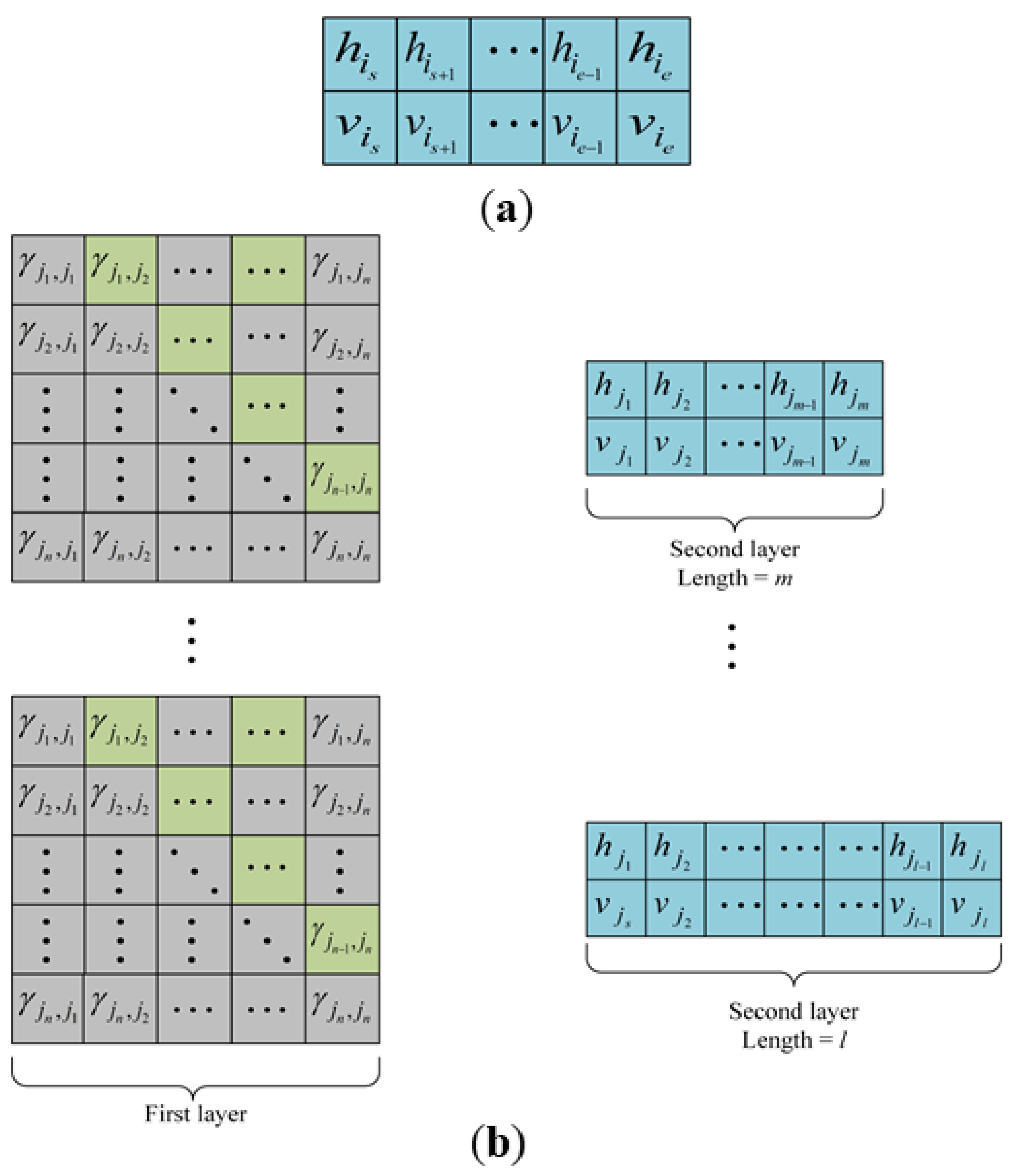
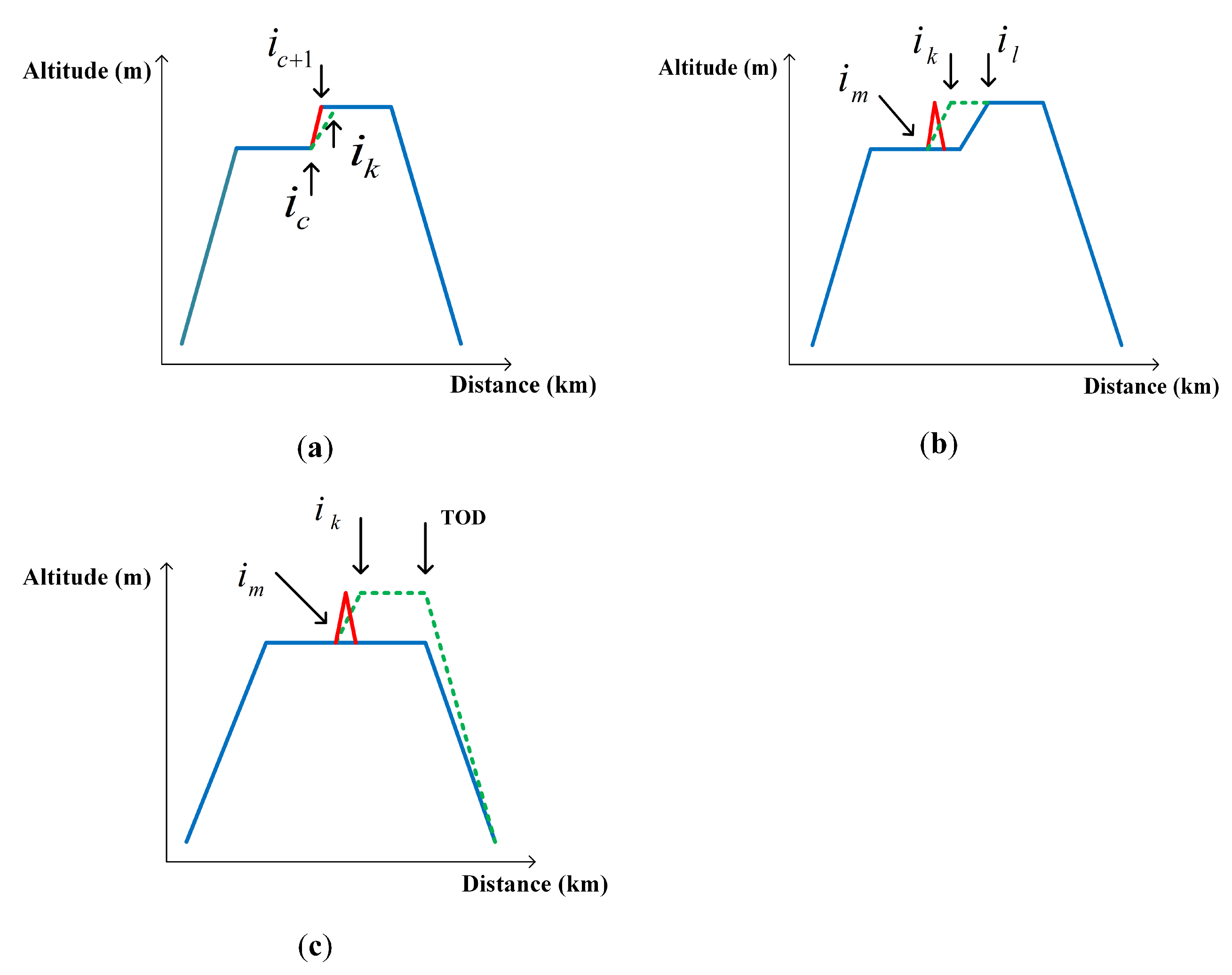



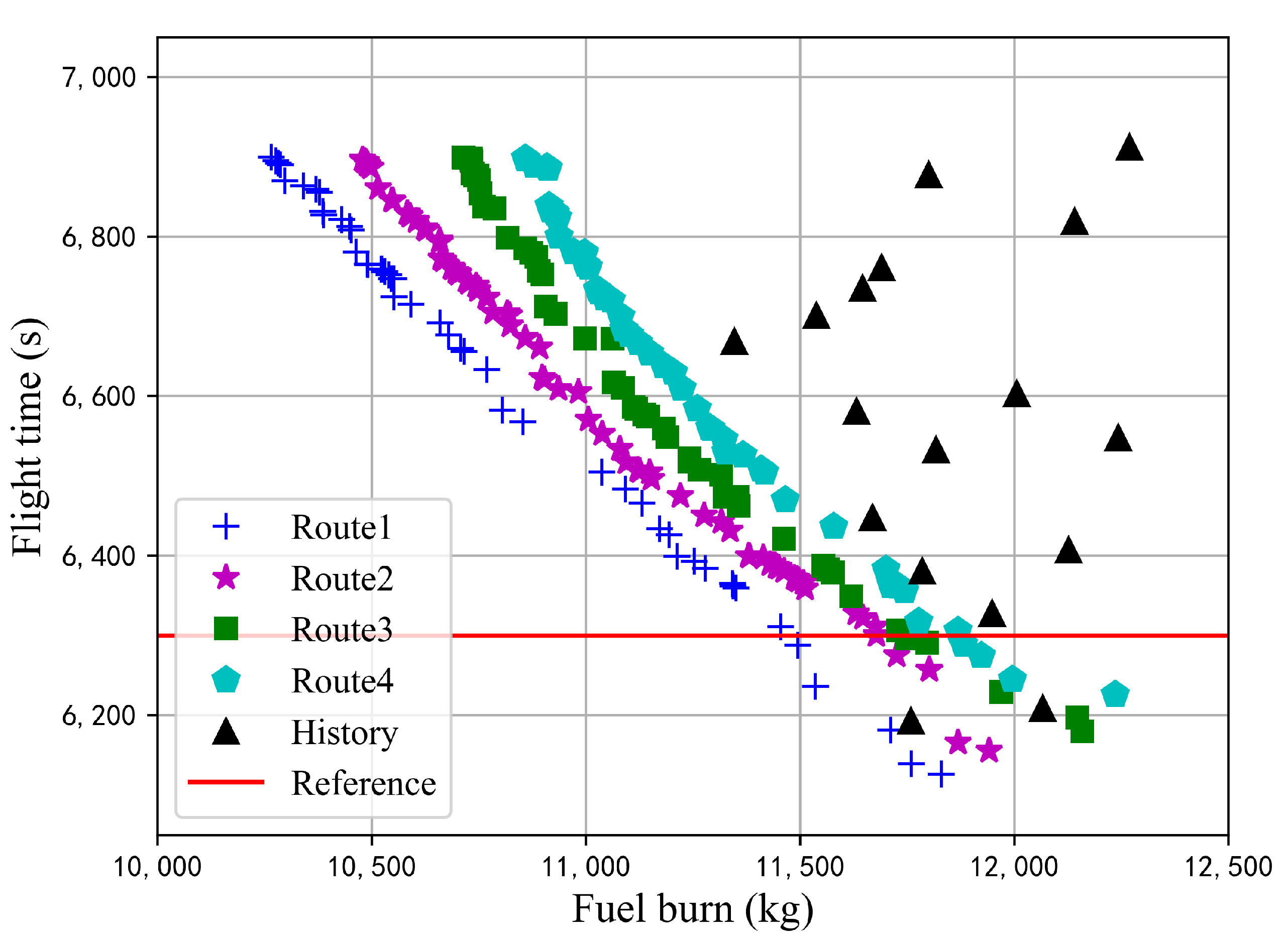
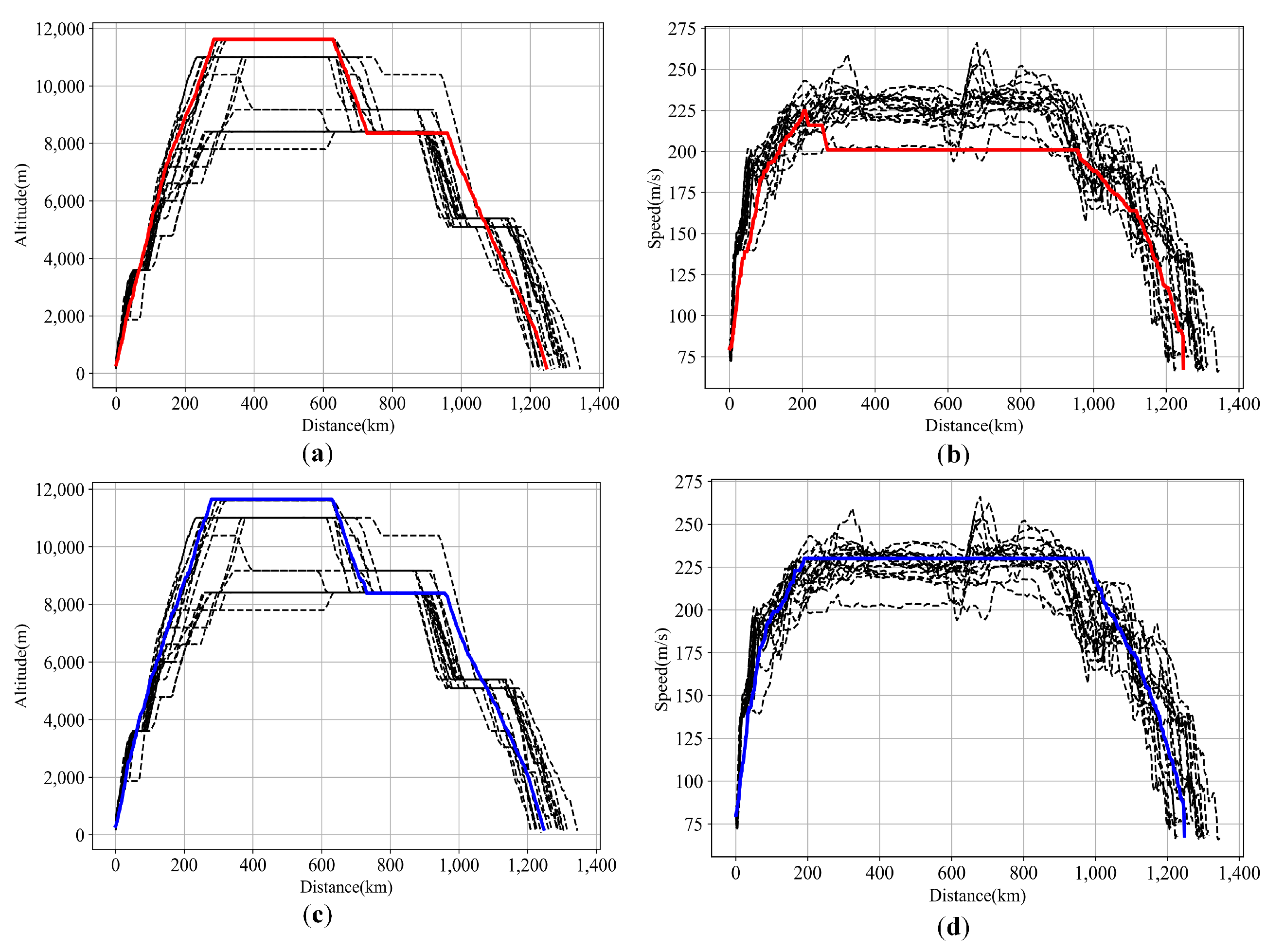

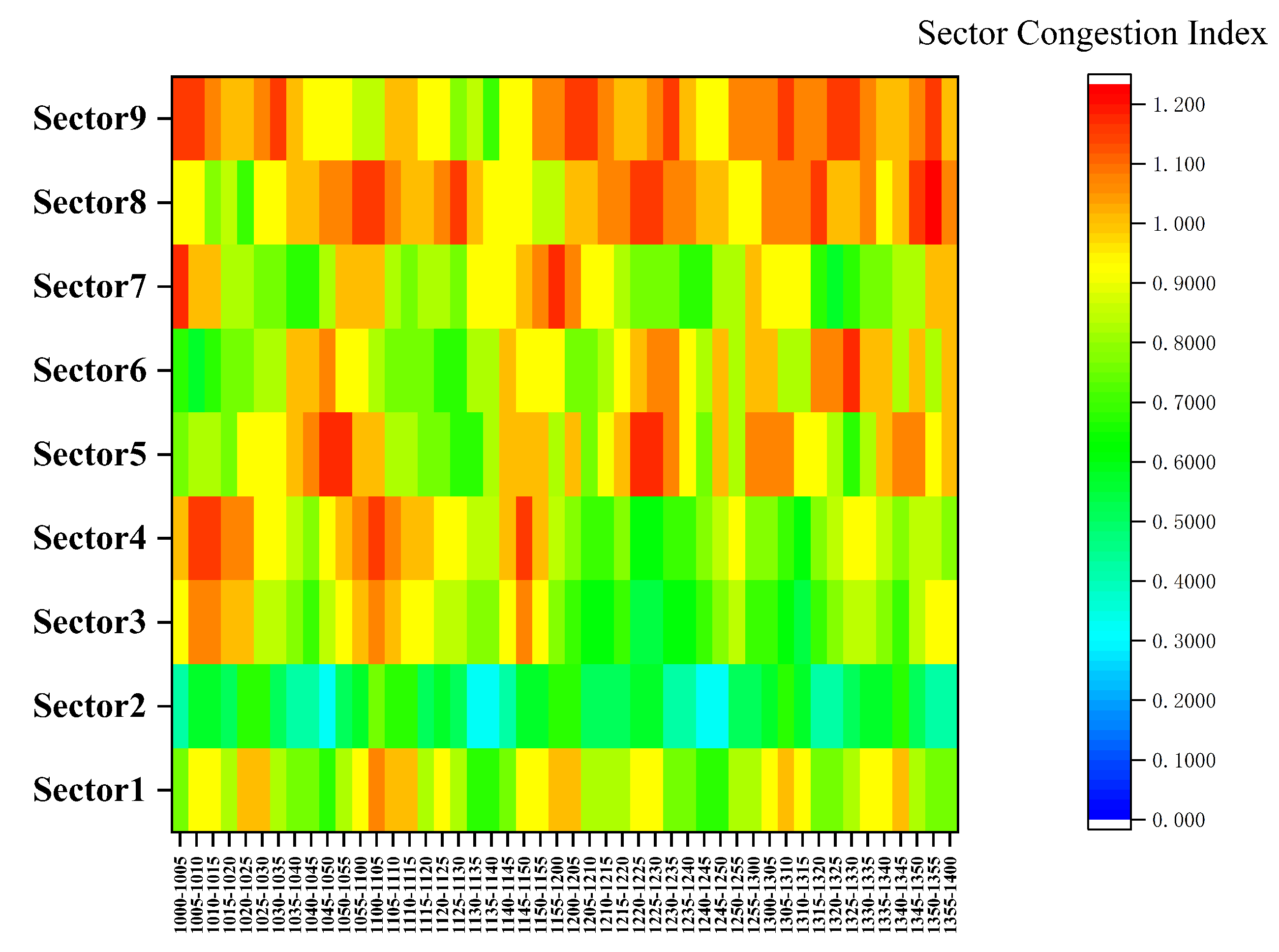
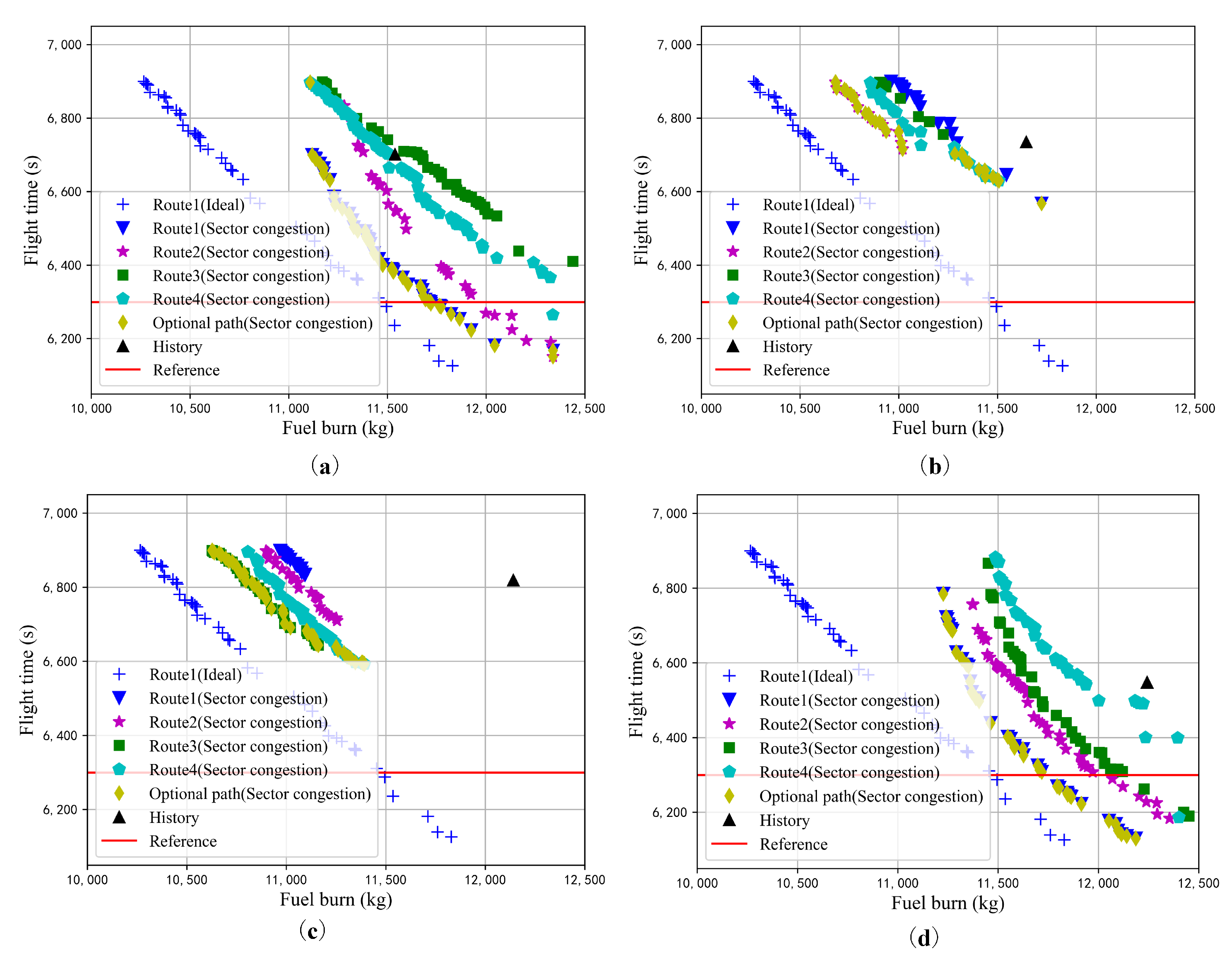
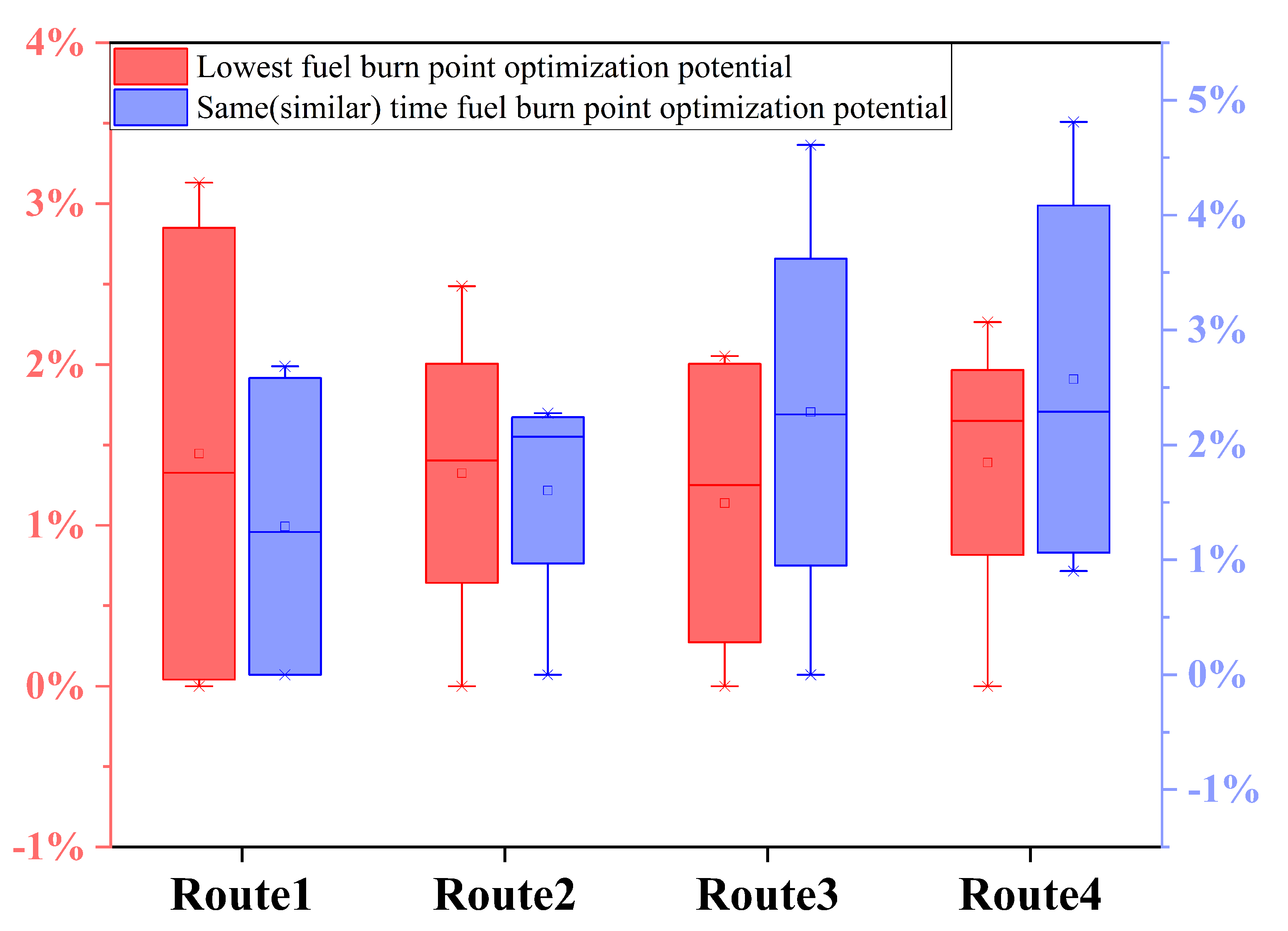

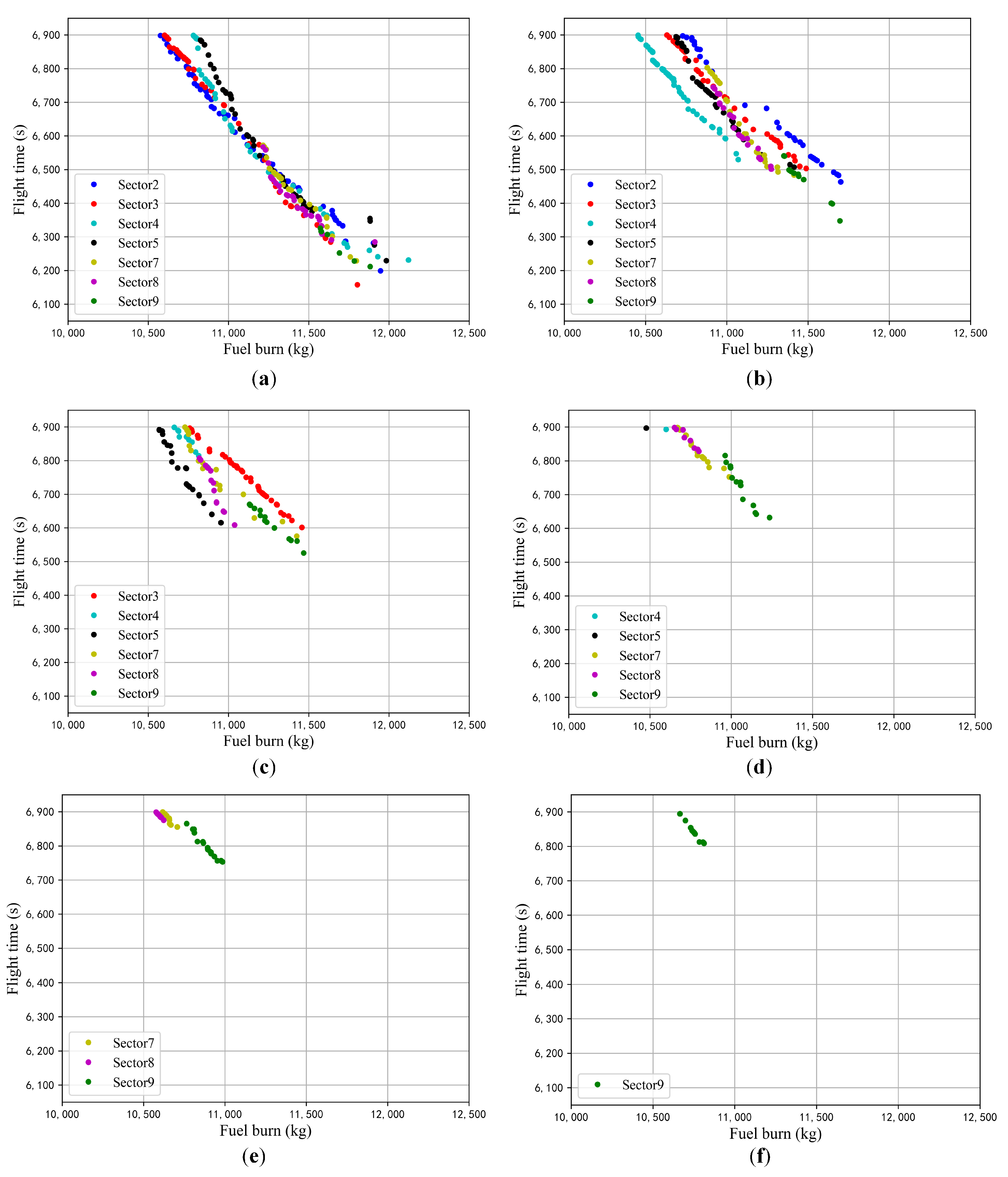
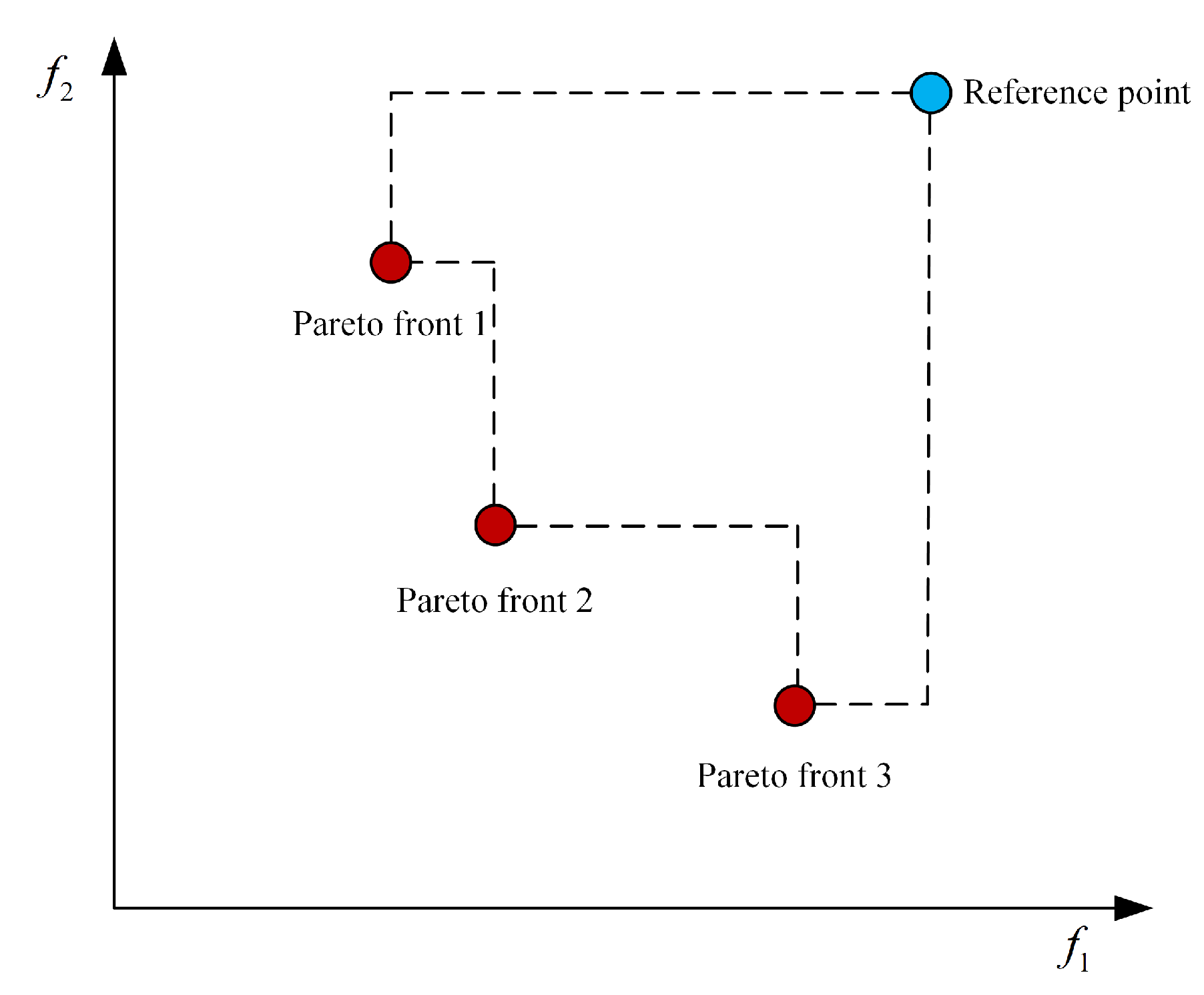
| Performance Parameter | Value |
|---|---|
| Reference mass (kg) | 174,000 |
| Wing area (m2) | 361.6 |
| Parasitic drag coefficient | 0.019805 |
| Induced drag coefficient | 0.031875 |
| First thrust-specific fuel consumption coefficient | 0.61503 |
| Second thrust-specific fuel consumption coefficient | 919.03 |
| Fuel flow correction factor during cruise | 0.93655 |
| Cruising Altitude (m) | Ratio | Flight Altitude before TOD (m) | Ratio |
|---|---|---|---|
| 7800 | 1.70% | - | - |
| 8400 | 13.80% | 8400 | 60.40% |
| 9200 | 8.60% | 9200 | 37.90% |
| 10,400 | 34.50% | 10,400 | 1.70% |
| 11,000 | 32.80% | - | - |
| 11,600 | 13.60% | - | - |
| Flight Code | Route 1 Lowest Fuel Consumption Point | Route 1 Standard Flight Time Point | Route 1 | Route 2 | Route 3 | Route 4 | Group |
|---|---|---|---|---|---|---|---|
| Flight 1 | 16.32% | 6.64% | 16.32% | 14.59% | 12.67% | 11.49% | 3 |
| Flight 2 | 14.49% | 4.60% | 10.00% | 8.53% | 7.66% | 6.51% | 3 |
| Flight 3 | 12.89% | 2.81% | 4.29% | 2.73% | 1.77% | 0.72% | 2 |
| Flight 4 | 12.70% | 2.59% | 0.41% | −0.93% | −3.29% | −4.05% | 1 |
| Flight 5 | 14.08% | 4.14% | 4.14% | 2.66% | 1.84% | 1.44% | 2 |
| Flight 6 | 13.13% | 3.07% | 6.60% | 6.25% | 4.88% | 4.15% | 2 |
| Flight 7 | 11.84% | 1.64% | 9.39% | 7.71% | 6.42% | 5.32% | 3 |
| Flight 8 | 13.00% | 2.94% | 12.75% | 11.04% | 8.97% | 7.53% | 3 |
| Flight 9 | 15.44% | 5.56% | 14.09% | 12.66% | 11.15% | 9.94% | 3 |
| Flight 10 | 11.74% | 1.52% | 7.11% | 5.38% | 4.42% | 3.19% | 2 |
| Flight 11 | 14.92% | 5.07% | 4.39% | 1.63% | −0.67% | −1.41% | 3 |
| Flight 12 | 12.18% | 2.02% | 9.98% | 8.59% | 6.85% | 5.86% | 1 |
| Flight 13 | 12.02% | 1.84% | 4.26% | 3.36% | 2.67% | 0.78% | 3 |
| Flight 14 | 16.15% | 6.64% | 11.36% | 9.84% | 8.60% | 7.52% | 2 |
| Flight 15 | 9.52% | −0.95% | 5.89% | 4.30% | 2.51% | 1.97% | 2 |
| Flight 16 | 11.02% | 0.72% | 7.61% | 6.21% | 5.28% | 3.95% | 3 |
| Flight 17 | 15.34% | 5.55% | 7.54% | 6.16% | 5.47% | 3.51% | 2 |
| Average optimization | 13.38% | 3.36% | 8.05% | 6.55% | 5.17% | 4.06% |
| Dependent Variable: Fuel Consumption Savings | |||||
|---|---|---|---|---|---|
| Source | Type III Sum of Squares | Df | Mean Square | F | p-Value |
| Correction model | 0.074 a | 11 | 0.007 | 7.786 | 0.000 |
| Intercept | 0.087 | 1 | 0.087 | 101.439 | 0.000 |
| Path | 0.013 | 3 | 0.004 | 5.114 | 0.003 |
| Period | 0.058 | 2 | 0.029 | 33.786 | 0.000 |
| Path * Period | 0.000 | 6 | 5.291 × 10 | 0.62 | 0.999 |
| Error | 0.048 | 56 | 0.001 | ||
| Total | 0.360 | 68 | |||
| Total after correction | 0.122 | 67 | |||
| Flight | Point of Optimal Fuel Consumption | Same or Similar Time Points | ||||||
|---|---|---|---|---|---|---|---|---|
| Route 1 | Route 2 | Route 3 | Route 4 | Route 1 | Route 2 | Route 3 | Route 4 | |
| Flight 1 | 0.08% | 1.52% | 0.54% | 0 | 0 | 2.28% | 4.61% | 3.36% |
| Flight 2 | 2.57% | 0 | 2.05% | 1.63% | 2.48% | 0 | 1.90% | 0.90% |
| Flight 3 | 3.13% | 2.49% | 0 | 1.67% | 2.68% | 2.20% | 0 | 1.22% |
| Flight 4 | 0 | 1.28% | 1.95% | 2.26% | 0 | 1.94% | 2.63% | 4.81% |
| Average optimization | 1.45% | 1.35% | 1.17% | 1.41% | 1.31% | 1.64% | 2.39% | 2.70% |
| Dependent Variable: Fuel Consumption Savings | |||||
|---|---|---|---|---|---|
| Source | Type III Sum of Squares | Df | Mean Square | F | p-Value |
| Correction model | 2,494,110.21 | 7 | 356,301.459 | 9.922 | 0.000 |
| Intercept | 314,423,0047 | 1 | 3,144,230,047 | 87,553.714 | 0.000 |
| Whether there is a candidate route | 217960.857 | 1 | 217,960.857 | 6.069 | 0.019 |
| Different aircraft | 1,401,258.350 | 3 | 467,086.117 | 13.006 | 0.00 |
| Whether there is a candidate route * Different aircraft | 2741.395 | 3 | 913.798 | 0.025 | 0.994 |
| Error | 1,149,184.398 | 32 | 35,912.012 | ||
| Total | 4,965,710,221 | 40 | |||
| Total after correction | 3,643,294.609 | 39 | |||
| Time Offset 2 min | Time Offset 4 min | Time Offset 6 min | Time Offset 8 min | Time Offset 10 min | Time Offset 12 min | |
|---|---|---|---|---|---|---|
| Sector 2 | 0.389475916 | 0.245791975 | ||||
| Sector 3 | 0.414667662 | 0.256870073 | 0.183452001 | |||
| Sector 4 | 0.379795425 | 0.285337554 | 0.090054089 | 0 | ||
| Sector 5 | 0.359588197 | 0.273687473 | 0.222181788 | 0 | ||
| Sector 7 | 0.339919746 | 0.269341927 | 0.214678477 | 0.11016196 | 0.036034223 | |
| Sector 8 | 0.327269913 | 0.262293323 | 0.207569953 | 0.055967497 | 0.020278687 | |
| Sector 9 | 0.27620746 | 0.278200685 | 0.21565125 | 0.174523766 | 0.107711289 | 0.071256447 |
Publisher’s Note: MDPI stays neutral with regard to jurisdictional claims in published maps and institutional affiliations. |
© 2021 by the authors. Licensee MDPI, Basel, Switzerland. This article is an open access article distributed under the terms and conditions of the Creative Commons Attribution (CC BY) license (https://creativecommons.org/licenses/by/4.0/).
Share and Cite
Liu, F.; Li, Z.; Xie, H.; Yang, L.; Hu, M. Predicting Fuel Consumption Reduction Potentials Based on 4D Trajectory Optimization with Heterogeneous Constraints. Sustainability 2021, 13, 7043. https://doi.org/10.3390/su13137043
Liu F, Li Z, Xie H, Yang L, Hu M. Predicting Fuel Consumption Reduction Potentials Based on 4D Trajectory Optimization with Heterogeneous Constraints. Sustainability. 2021; 13(13):7043. https://doi.org/10.3390/su13137043
Chicago/Turabian StyleLiu, Fangzi, Zihong Li, Hua Xie, Lei Yang, and Minghua Hu. 2021. "Predicting Fuel Consumption Reduction Potentials Based on 4D Trajectory Optimization with Heterogeneous Constraints" Sustainability 13, no. 13: 7043. https://doi.org/10.3390/su13137043
APA StyleLiu, F., Li, Z., Xie, H., Yang, L., & Hu, M. (2021). Predicting Fuel Consumption Reduction Potentials Based on 4D Trajectory Optimization with Heterogeneous Constraints. Sustainability, 13(13), 7043. https://doi.org/10.3390/su13137043






